University Retail Report: UK Grocery Market Analysis and Strategies
VerifiedAdded on 2023/04/17
|12
|3509
|488
Report
AI Summary
This report provides a comprehensive analysis of the UK grocery market, focusing on key changes and strategies for retailers. It begins with an introduction to the retail industry and the competitive landscape, highlighting the dominance of major players like Tesco. The report then delves into a detailed PESTEL analysis, examining political, economic, social, technological, environmental, and legal factors influencing the market. It explores specific challenges such as the impact of Brexit, economic fluctuations, and changing consumer behaviors. Furthermore, the report analyzes the micro-environment, focusing on factors like competitors, consumers, and suppliers. It also discusses consumer attitudes and behaviors, including the impact of income, urbanization, and technological advancements. Finally, the report suggests strategies and tactics that retailers can use to respond to these market changes, such as focusing on impulse sales and adapting to evolving consumer needs.
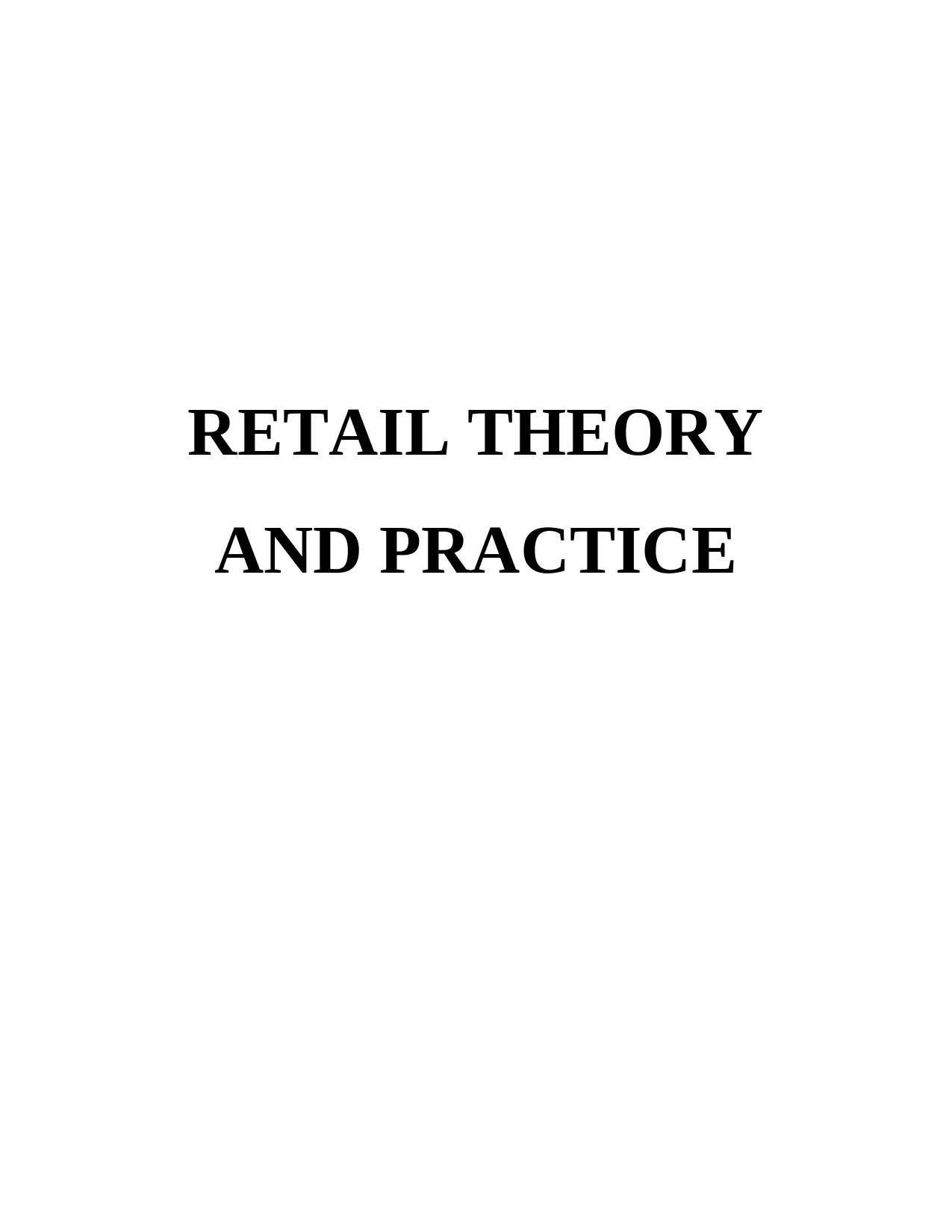
RETAIL THEORY
AND PRACTICE
AND PRACTICE
Paraphrase This Document
Need a fresh take? Get an instant paraphrase of this document with our AI Paraphraser
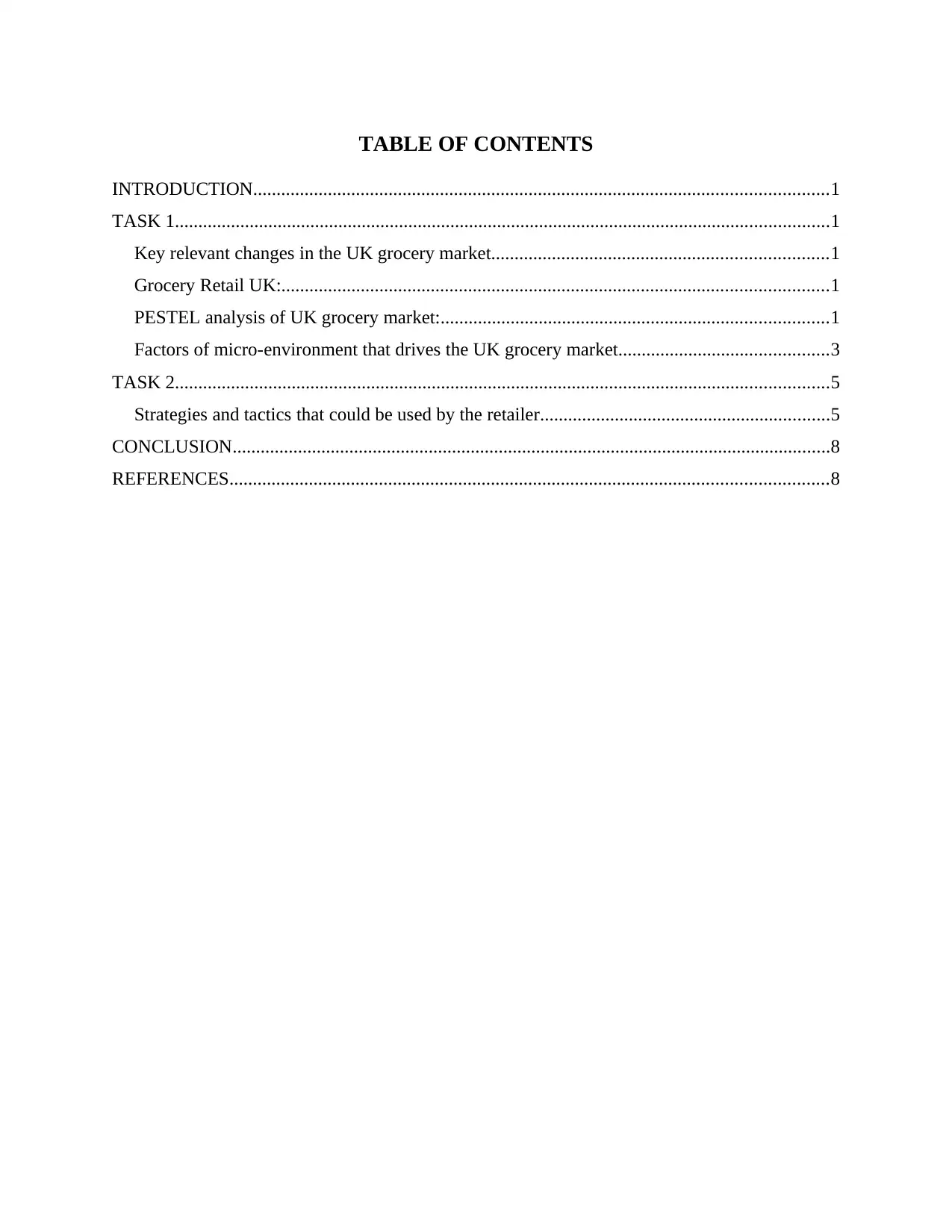
TABLE OF CONTENTS
INTRODUCTION...........................................................................................................................1
TASK 1............................................................................................................................................1
Key relevant changes in the UK grocery market........................................................................1
Grocery Retail UK:.....................................................................................................................1
PESTEL analysis of UK grocery market:...................................................................................1
Factors of micro-environment that drives the UK grocery market.............................................3
TASK 2............................................................................................................................................5
Strategies and tactics that could be used by the retailer..............................................................5
CONCLUSION................................................................................................................................8
REFERENCES................................................................................................................................8
INTRODUCTION...........................................................................................................................1
TASK 1............................................................................................................................................1
Key relevant changes in the UK grocery market........................................................................1
Grocery Retail UK:.....................................................................................................................1
PESTEL analysis of UK grocery market:...................................................................................1
Factors of micro-environment that drives the UK grocery market.............................................3
TASK 2............................................................................................................................................5
Strategies and tactics that could be used by the retailer..............................................................5
CONCLUSION................................................................................................................................8
REFERENCES................................................................................................................................8
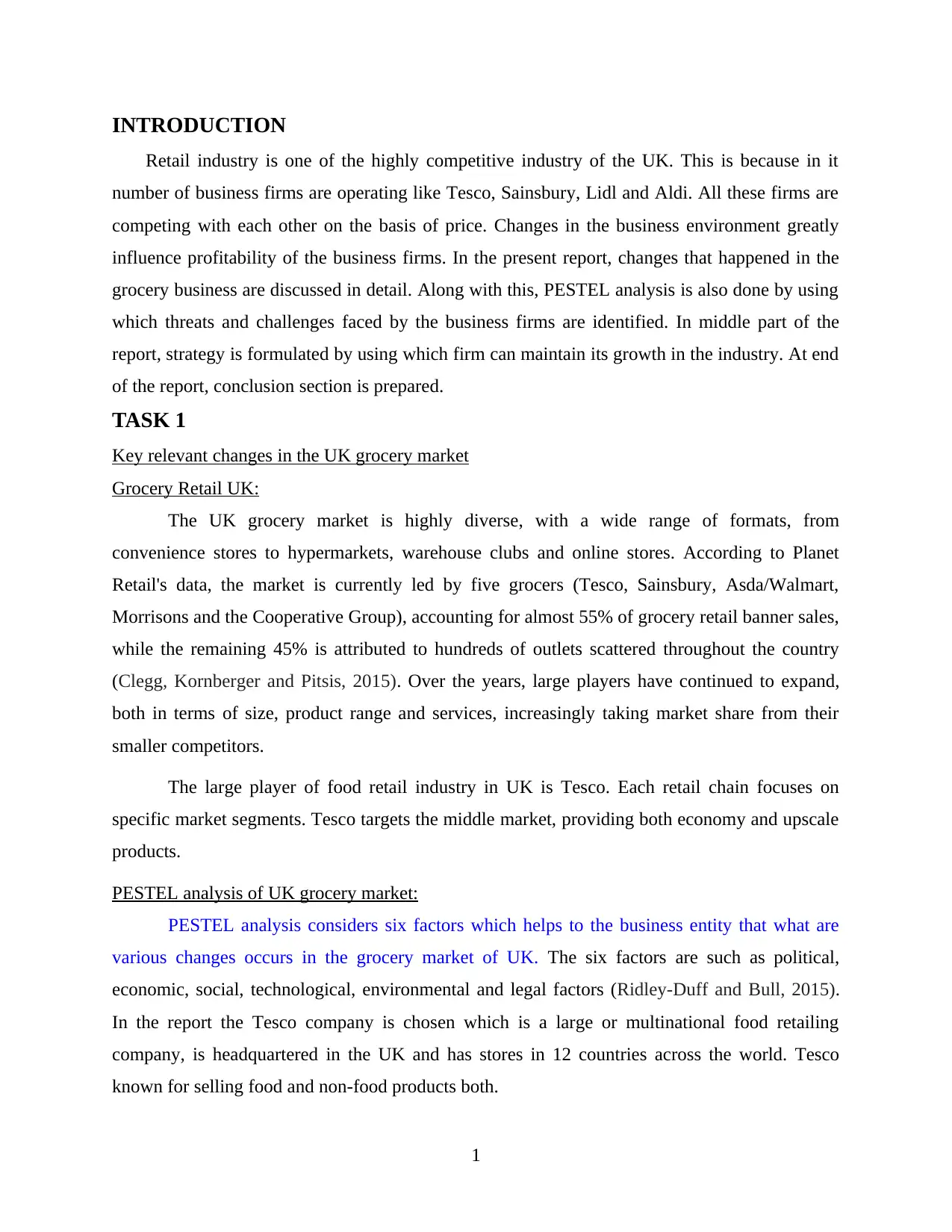
INTRODUCTION
Retail industry is one of the highly competitive industry of the UK. This is because in it
number of business firms are operating like Tesco, Sainsbury, Lidl and Aldi. All these firms are
competing with each other on the basis of price. Changes in the business environment greatly
influence profitability of the business firms. In the present report, changes that happened in the
grocery business are discussed in detail. Along with this, PESTEL analysis is also done by using
which threats and challenges faced by the business firms are identified. In middle part of the
report, strategy is formulated by using which firm can maintain its growth in the industry. At end
of the report, conclusion section is prepared.
TASK 1
Key relevant changes in the UK grocery market
Grocery Retail UK:
The UK grocery market is highly diverse, with a wide range of formats, from
convenience stores to hypermarkets, warehouse clubs and online stores. According to Planet
Retail's data, the market is currently led by five grocers (Tesco, Sainsbury, Asda/Walmart,
Morrisons and the Cooperative Group), accounting for almost 55% of grocery retail banner sales,
while the remaining 45% is attributed to hundreds of outlets scattered throughout the country
(Clegg, Kornberger and Pitsis, 2015). Over the years, large players have continued to expand,
both in terms of size, product range and services, increasingly taking market share from their
smaller competitors.
The large player of food retail industry in UK is Tesco. Each retail chain focuses on
specific market segments. Tesco targets the middle market, providing both economy and upscale
products.
PESTEL analysis of UK grocery market:
PESTEL analysis considers six factors which helps to the business entity that what are
various changes occurs in the grocery market of UK. The six factors are such as political,
economic, social, technological, environmental and legal factors (Ridley-Duff and Bull, 2015).
In the report the Tesco company is chosen which is a large or multinational food retailing
company, is headquartered in the UK and has stores in 12 countries across the world. Tesco
known for selling food and non-food products both.
1
Retail industry is one of the highly competitive industry of the UK. This is because in it
number of business firms are operating like Tesco, Sainsbury, Lidl and Aldi. All these firms are
competing with each other on the basis of price. Changes in the business environment greatly
influence profitability of the business firms. In the present report, changes that happened in the
grocery business are discussed in detail. Along with this, PESTEL analysis is also done by using
which threats and challenges faced by the business firms are identified. In middle part of the
report, strategy is formulated by using which firm can maintain its growth in the industry. At end
of the report, conclusion section is prepared.
TASK 1
Key relevant changes in the UK grocery market
Grocery Retail UK:
The UK grocery market is highly diverse, with a wide range of formats, from
convenience stores to hypermarkets, warehouse clubs and online stores. According to Planet
Retail's data, the market is currently led by five grocers (Tesco, Sainsbury, Asda/Walmart,
Morrisons and the Cooperative Group), accounting for almost 55% of grocery retail banner sales,
while the remaining 45% is attributed to hundreds of outlets scattered throughout the country
(Clegg, Kornberger and Pitsis, 2015). Over the years, large players have continued to expand,
both in terms of size, product range and services, increasingly taking market share from their
smaller competitors.
The large player of food retail industry in UK is Tesco. Each retail chain focuses on
specific market segments. Tesco targets the middle market, providing both economy and upscale
products.
PESTEL analysis of UK grocery market:
PESTEL analysis considers six factors which helps to the business entity that what are
various changes occurs in the grocery market of UK. The six factors are such as political,
economic, social, technological, environmental and legal factors (Ridley-Duff and Bull, 2015).
In the report the Tesco company is chosen which is a large or multinational food retailing
company, is headquartered in the UK and has stores in 12 countries across the world. Tesco
known for selling food and non-food products both.
1
⊘ This is a preview!⊘
Do you want full access?
Subscribe today to unlock all pages.

Trusted by 1+ million students worldwide
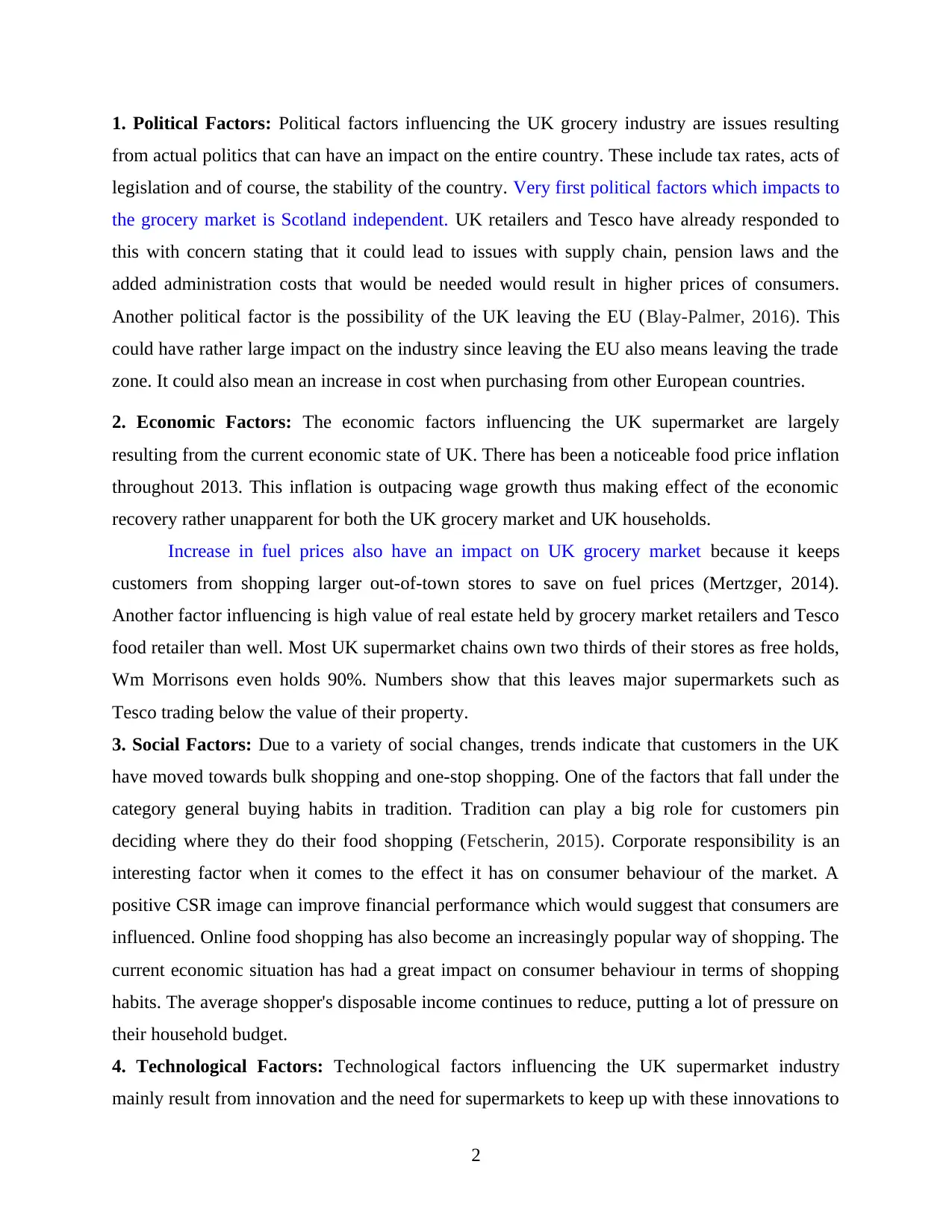
1. Political Factors: Political factors influencing the UK grocery industry are issues resulting
from actual politics that can have an impact on the entire country. These include tax rates, acts of
legislation and of course, the stability of the country. Very first political factors which impacts to
the grocery market is Scotland independent. UK retailers and Tesco have already responded to
this with concern stating that it could lead to issues with supply chain, pension laws and the
added administration costs that would be needed would result in higher prices of consumers.
Another political factor is the possibility of the UK leaving the EU (Blay-Palmer, 2016). This
could have rather large impact on the industry since leaving the EU also means leaving the trade
zone. It could also mean an increase in cost when purchasing from other European countries.
2. Economic Factors: The economic factors influencing the UK supermarket are largely
resulting from the current economic state of UK. There has been a noticeable food price inflation
throughout 2013. This inflation is outpacing wage growth thus making effect of the economic
recovery rather unapparent for both the UK grocery market and UK households.
Increase in fuel prices also have an impact on UK grocery market because it keeps
customers from shopping larger out-of-town stores to save on fuel prices (Mertzger, 2014).
Another factor influencing is high value of real estate held by grocery market retailers and Tesco
food retailer than well. Most UK supermarket chains own two thirds of their stores as free holds,
Wm Morrisons even holds 90%. Numbers show that this leaves major supermarkets such as
Tesco trading below the value of their property.
3. Social Factors: Due to a variety of social changes, trends indicate that customers in the UK
have moved towards bulk shopping and one-stop shopping. One of the factors that fall under the
category general buying habits in tradition. Tradition can play a big role for customers pin
deciding where they do their food shopping (Fetscherin, 2015). Corporate responsibility is an
interesting factor when it comes to the effect it has on consumer behaviour of the market. A
positive CSR image can improve financial performance which would suggest that consumers are
influenced. Online food shopping has also become an increasingly popular way of shopping. The
current economic situation has had a great impact on consumer behaviour in terms of shopping
habits. The average shopper's disposable income continues to reduce, putting a lot of pressure on
their household budget.
4. Technological Factors: Technological factors influencing the UK supermarket industry
mainly result from innovation and the need for supermarkets to keep up with these innovations to
2
from actual politics that can have an impact on the entire country. These include tax rates, acts of
legislation and of course, the stability of the country. Very first political factors which impacts to
the grocery market is Scotland independent. UK retailers and Tesco have already responded to
this with concern stating that it could lead to issues with supply chain, pension laws and the
added administration costs that would be needed would result in higher prices of consumers.
Another political factor is the possibility of the UK leaving the EU (Blay-Palmer, 2016). This
could have rather large impact on the industry since leaving the EU also means leaving the trade
zone. It could also mean an increase in cost when purchasing from other European countries.
2. Economic Factors: The economic factors influencing the UK supermarket are largely
resulting from the current economic state of UK. There has been a noticeable food price inflation
throughout 2013. This inflation is outpacing wage growth thus making effect of the economic
recovery rather unapparent for both the UK grocery market and UK households.
Increase in fuel prices also have an impact on UK grocery market because it keeps
customers from shopping larger out-of-town stores to save on fuel prices (Mertzger, 2014).
Another factor influencing is high value of real estate held by grocery market retailers and Tesco
food retailer than well. Most UK supermarket chains own two thirds of their stores as free holds,
Wm Morrisons even holds 90%. Numbers show that this leaves major supermarkets such as
Tesco trading below the value of their property.
3. Social Factors: Due to a variety of social changes, trends indicate that customers in the UK
have moved towards bulk shopping and one-stop shopping. One of the factors that fall under the
category general buying habits in tradition. Tradition can play a big role for customers pin
deciding where they do their food shopping (Fetscherin, 2015). Corporate responsibility is an
interesting factor when it comes to the effect it has on consumer behaviour of the market. A
positive CSR image can improve financial performance which would suggest that consumers are
influenced. Online food shopping has also become an increasingly popular way of shopping. The
current economic situation has had a great impact on consumer behaviour in terms of shopping
habits. The average shopper's disposable income continues to reduce, putting a lot of pressure on
their household budget.
4. Technological Factors: Technological factors influencing the UK supermarket industry
mainly result from innovation and the need for supermarkets to keep up with these innovations to
2
Paraphrase This Document
Need a fresh take? Get an instant paraphrase of this document with our AI Paraphraser
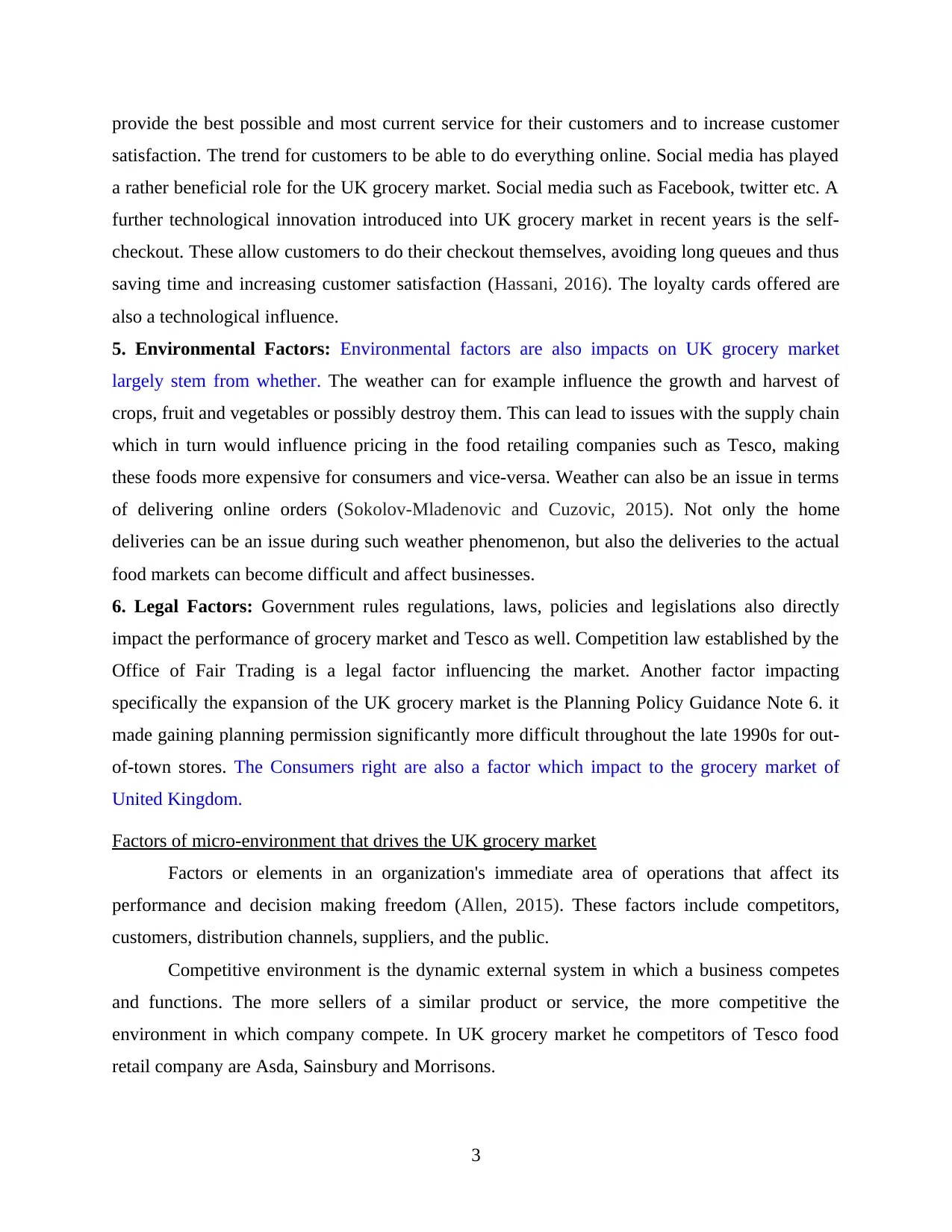
provide the best possible and most current service for their customers and to increase customer
satisfaction. The trend for customers to be able to do everything online. Social media has played
a rather beneficial role for the UK grocery market. Social media such as Facebook, twitter etc. A
further technological innovation introduced into UK grocery market in recent years is the self-
checkout. These allow customers to do their checkout themselves, avoiding long queues and thus
saving time and increasing customer satisfaction (Hassani, 2016). The loyalty cards offered are
also a technological influence.
5. Environmental Factors: Environmental factors are also impacts on UK grocery market
largely stem from whether. The weather can for example influence the growth and harvest of
crops, fruit and vegetables or possibly destroy them. This can lead to issues with the supply chain
which in turn would influence pricing in the food retailing companies such as Tesco, making
these foods more expensive for consumers and vice-versa. Weather can also be an issue in terms
of delivering online orders (Sokolov-Mladenovic and Cuzovic, 2015). Not only the home
deliveries can be an issue during such weather phenomenon, but also the deliveries to the actual
food markets can become difficult and affect businesses.
6. Legal Factors: Government rules regulations, laws, policies and legislations also directly
impact the performance of grocery market and Tesco as well. Competition law established by the
Office of Fair Trading is a legal factor influencing the market. Another factor impacting
specifically the expansion of the UK grocery market is the Planning Policy Guidance Note 6. it
made gaining planning permission significantly more difficult throughout the late 1990s for out-
of-town stores. The Consumers right are also a factor which impact to the grocery market of
United Kingdom.
Factors of micro-environment that drives the UK grocery market
Factors or elements in an organization's immediate area of operations that affect its
performance and decision making freedom (Allen, 2015). These factors include competitors,
customers, distribution channels, suppliers, and the public.
Competitive environment is the dynamic external system in which a business competes
and functions. The more sellers of a similar product or service, the more competitive the
environment in which company compete. In UK grocery market he competitors of Tesco food
retail company are Asda, Sainsbury and Morrisons.
3
satisfaction. The trend for customers to be able to do everything online. Social media has played
a rather beneficial role for the UK grocery market. Social media such as Facebook, twitter etc. A
further technological innovation introduced into UK grocery market in recent years is the self-
checkout. These allow customers to do their checkout themselves, avoiding long queues and thus
saving time and increasing customer satisfaction (Hassani, 2016). The loyalty cards offered are
also a technological influence.
5. Environmental Factors: Environmental factors are also impacts on UK grocery market
largely stem from whether. The weather can for example influence the growth and harvest of
crops, fruit and vegetables or possibly destroy them. This can lead to issues with the supply chain
which in turn would influence pricing in the food retailing companies such as Tesco, making
these foods more expensive for consumers and vice-versa. Weather can also be an issue in terms
of delivering online orders (Sokolov-Mladenovic and Cuzovic, 2015). Not only the home
deliveries can be an issue during such weather phenomenon, but also the deliveries to the actual
food markets can become difficult and affect businesses.
6. Legal Factors: Government rules regulations, laws, policies and legislations also directly
impact the performance of grocery market and Tesco as well. Competition law established by the
Office of Fair Trading is a legal factor influencing the market. Another factor impacting
specifically the expansion of the UK grocery market is the Planning Policy Guidance Note 6. it
made gaining planning permission significantly more difficult throughout the late 1990s for out-
of-town stores. The Consumers right are also a factor which impact to the grocery market of
United Kingdom.
Factors of micro-environment that drives the UK grocery market
Factors or elements in an organization's immediate area of operations that affect its
performance and decision making freedom (Allen, 2015). These factors include competitors,
customers, distribution channels, suppliers, and the public.
Competitive environment is the dynamic external system in which a business competes
and functions. The more sellers of a similar product or service, the more competitive the
environment in which company compete. In UK grocery market he competitors of Tesco food
retail company are Asda, Sainsbury and Morrisons.
3
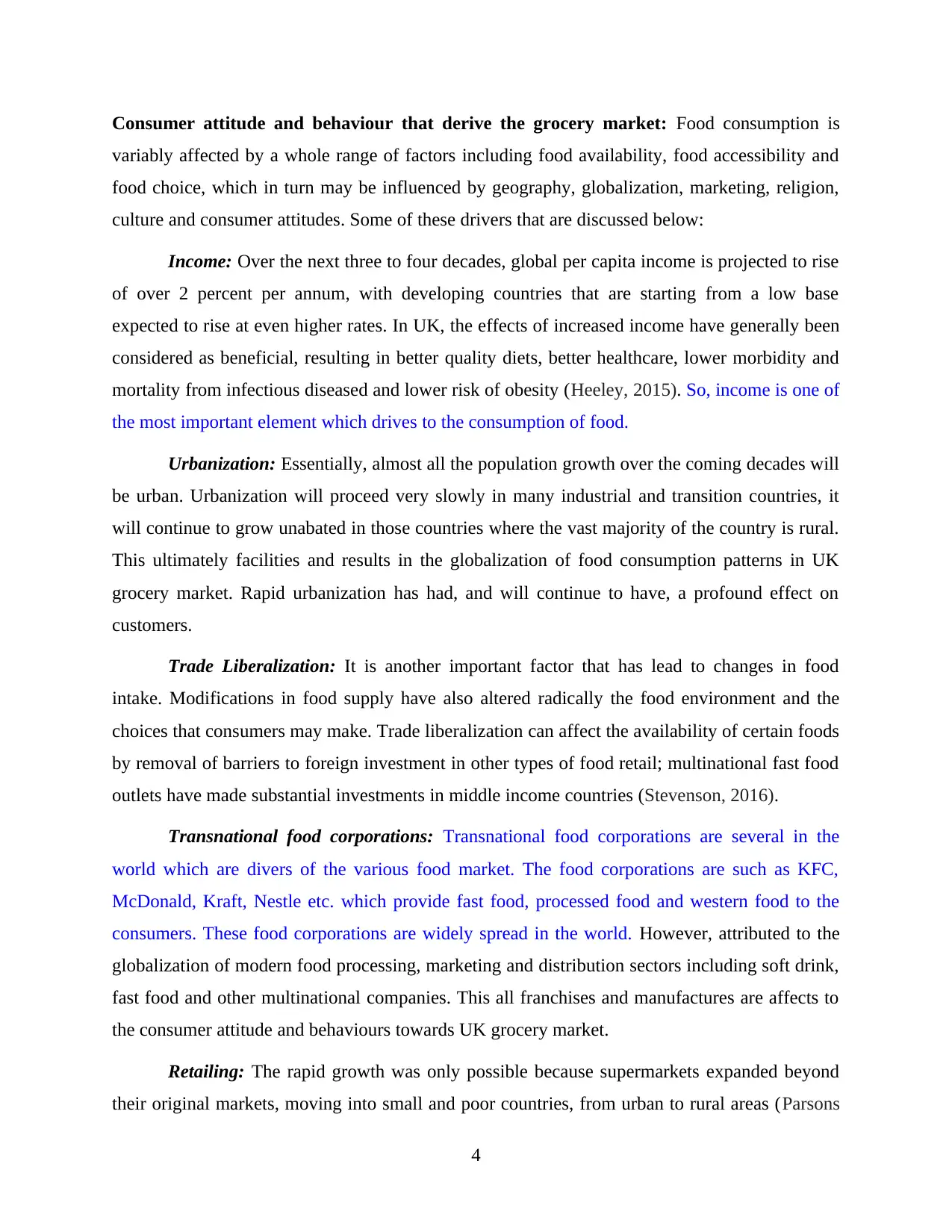
Consumer attitude and behaviour that derive the grocery market: Food consumption is
variably affected by a whole range of factors including food availability, food accessibility and
food choice, which in turn may be influenced by geography, globalization, marketing, religion,
culture and consumer attitudes. Some of these drivers that are discussed below:
Income: Over the next three to four decades, global per capita income is projected to rise
of over 2 percent per annum, with developing countries that are starting from a low base
expected to rise at even higher rates. In UK, the effects of increased income have generally been
considered as beneficial, resulting in better quality diets, better healthcare, lower morbidity and
mortality from infectious diseased and lower risk of obesity (Heeley, 2015). So, income is one of
the most important element which drives to the consumption of food.
Urbanization: Essentially, almost all the population growth over the coming decades will
be urban. Urbanization will proceed very slowly in many industrial and transition countries, it
will continue to grow unabated in those countries where the vast majority of the country is rural.
This ultimately facilities and results in the globalization of food consumption patterns in UK
grocery market. Rapid urbanization has had, and will continue to have, a profound effect on
customers.
Trade Liberalization: It is another important factor that has lead to changes in food
intake. Modifications in food supply have also altered radically the food environment and the
choices that consumers may make. Trade liberalization can affect the availability of certain foods
by removal of barriers to foreign investment in other types of food retail; multinational fast food
outlets have made substantial investments in middle income countries (Stevenson, 2016).
Transnational food corporations: Transnational food corporations are several in the
world which are divers of the various food market. The food corporations are such as KFC,
McDonald, Kraft, Nestle etc. which provide fast food, processed food and western food to the
consumers. These food corporations are widely spread in the world. However, attributed to the
globalization of modern food processing, marketing and distribution sectors including soft drink,
fast food and other multinational companies. This all franchises and manufactures are affects to
the consumer attitude and behaviours towards UK grocery market.
Retailing: The rapid growth was only possible because supermarkets expanded beyond
their original markets, moving into small and poor countries, from urban to rural areas (Parsons
4
variably affected by a whole range of factors including food availability, food accessibility and
food choice, which in turn may be influenced by geography, globalization, marketing, religion,
culture and consumer attitudes. Some of these drivers that are discussed below:
Income: Over the next three to four decades, global per capita income is projected to rise
of over 2 percent per annum, with developing countries that are starting from a low base
expected to rise at even higher rates. In UK, the effects of increased income have generally been
considered as beneficial, resulting in better quality diets, better healthcare, lower morbidity and
mortality from infectious diseased and lower risk of obesity (Heeley, 2015). So, income is one of
the most important element which drives to the consumption of food.
Urbanization: Essentially, almost all the population growth over the coming decades will
be urban. Urbanization will proceed very slowly in many industrial and transition countries, it
will continue to grow unabated in those countries where the vast majority of the country is rural.
This ultimately facilities and results in the globalization of food consumption patterns in UK
grocery market. Rapid urbanization has had, and will continue to have, a profound effect on
customers.
Trade Liberalization: It is another important factor that has lead to changes in food
intake. Modifications in food supply have also altered radically the food environment and the
choices that consumers may make. Trade liberalization can affect the availability of certain foods
by removal of barriers to foreign investment in other types of food retail; multinational fast food
outlets have made substantial investments in middle income countries (Stevenson, 2016).
Transnational food corporations: Transnational food corporations are several in the
world which are divers of the various food market. The food corporations are such as KFC,
McDonald, Kraft, Nestle etc. which provide fast food, processed food and western food to the
consumers. These food corporations are widely spread in the world. However, attributed to the
globalization of modern food processing, marketing and distribution sectors including soft drink,
fast food and other multinational companies. This all franchises and manufactures are affects to
the consumer attitude and behaviours towards UK grocery market.
Retailing: The rapid growth was only possible because supermarkets expanded beyond
their original markets, moving into small and poor countries, from urban to rural areas (Parsons
4
⊘ This is a preview!⊘
Do you want full access?
Subscribe today to unlock all pages.

Trusted by 1+ million students worldwide
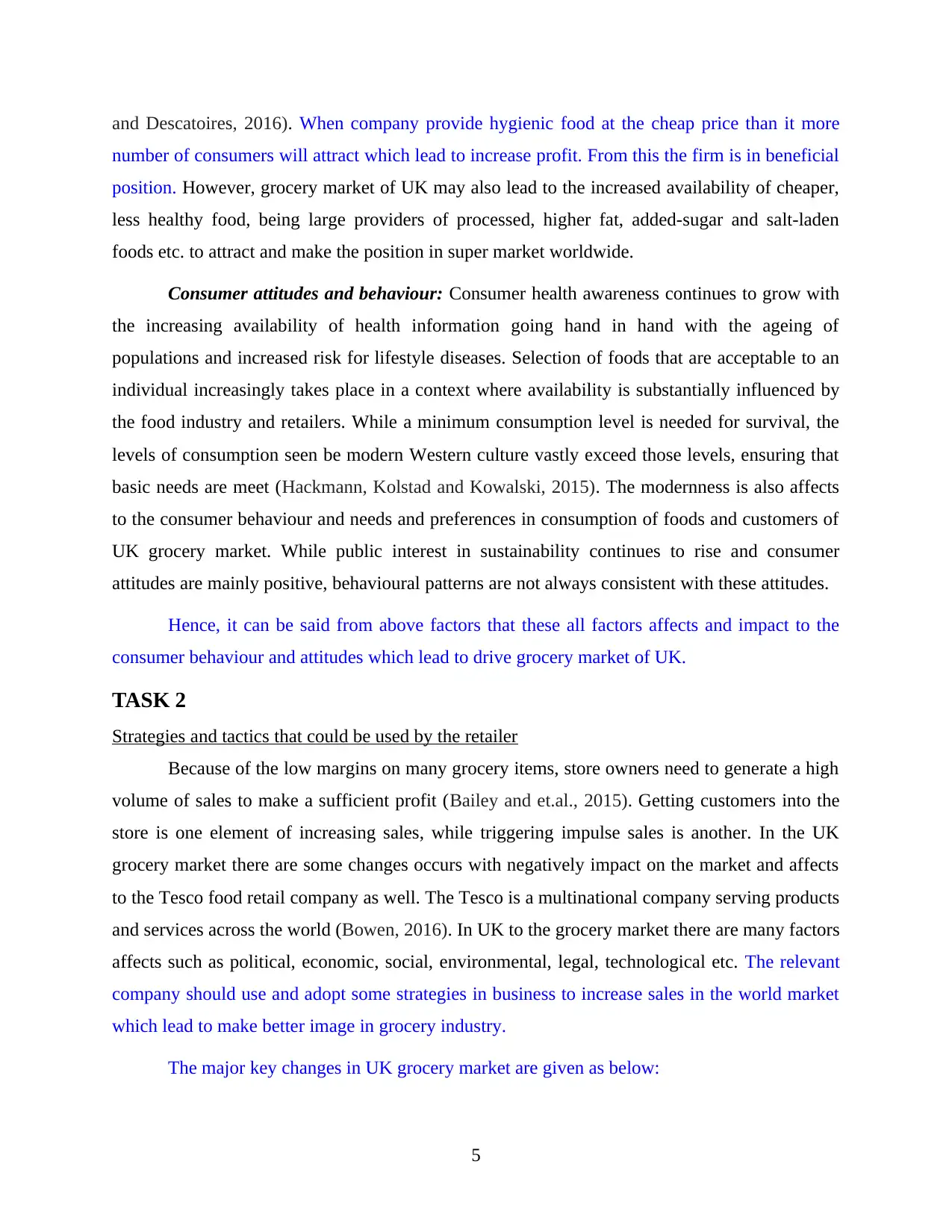
and Descatoires, 2016). When company provide hygienic food at the cheap price than it more
number of consumers will attract which lead to increase profit. From this the firm is in beneficial
position. However, grocery market of UK may also lead to the increased availability of cheaper,
less healthy food, being large providers of processed, higher fat, added-sugar and salt-laden
foods etc. to attract and make the position in super market worldwide.
Consumer attitudes and behaviour: Consumer health awareness continues to grow with
the increasing availability of health information going hand in hand with the ageing of
populations and increased risk for lifestyle diseases. Selection of foods that are acceptable to an
individual increasingly takes place in a context where availability is substantially influenced by
the food industry and retailers. While a minimum consumption level is needed for survival, the
levels of consumption seen be modern Western culture vastly exceed those levels, ensuring that
basic needs are meet (Hackmann, Kolstad and Kowalski, 2015). The modernness is also affects
to the consumer behaviour and needs and preferences in consumption of foods and customers of
UK grocery market. While public interest in sustainability continues to rise and consumer
attitudes are mainly positive, behavioural patterns are not always consistent with these attitudes.
Hence, it can be said from above factors that these all factors affects and impact to the
consumer behaviour and attitudes which lead to drive grocery market of UK.
TASK 2
Strategies and tactics that could be used by the retailer
Because of the low margins on many grocery items, store owners need to generate a high
volume of sales to make a sufficient profit (Bailey and et.al., 2015). Getting customers into the
store is one element of increasing sales, while triggering impulse sales is another. In the UK
grocery market there are some changes occurs with negatively impact on the market and affects
to the Tesco food retail company as well. The Tesco is a multinational company serving products
and services across the world (Bowen, 2016). In UK to the grocery market there are many factors
affects such as political, economic, social, environmental, legal, technological etc. The relevant
company should use and adopt some strategies in business to increase sales in the world market
which lead to make better image in grocery industry.
The major key changes in UK grocery market are given as below:
5
number of consumers will attract which lead to increase profit. From this the firm is in beneficial
position. However, grocery market of UK may also lead to the increased availability of cheaper,
less healthy food, being large providers of processed, higher fat, added-sugar and salt-laden
foods etc. to attract and make the position in super market worldwide.
Consumer attitudes and behaviour: Consumer health awareness continues to grow with
the increasing availability of health information going hand in hand with the ageing of
populations and increased risk for lifestyle diseases. Selection of foods that are acceptable to an
individual increasingly takes place in a context where availability is substantially influenced by
the food industry and retailers. While a minimum consumption level is needed for survival, the
levels of consumption seen be modern Western culture vastly exceed those levels, ensuring that
basic needs are meet (Hackmann, Kolstad and Kowalski, 2015). The modernness is also affects
to the consumer behaviour and needs and preferences in consumption of foods and customers of
UK grocery market. While public interest in sustainability continues to rise and consumer
attitudes are mainly positive, behavioural patterns are not always consistent with these attitudes.
Hence, it can be said from above factors that these all factors affects and impact to the
consumer behaviour and attitudes which lead to drive grocery market of UK.
TASK 2
Strategies and tactics that could be used by the retailer
Because of the low margins on many grocery items, store owners need to generate a high
volume of sales to make a sufficient profit (Bailey and et.al., 2015). Getting customers into the
store is one element of increasing sales, while triggering impulse sales is another. In the UK
grocery market there are some changes occurs with negatively impact on the market and affects
to the Tesco food retail company as well. The Tesco is a multinational company serving products
and services across the world (Bowen, 2016). In UK to the grocery market there are many factors
affects such as political, economic, social, environmental, legal, technological etc. The relevant
company should use and adopt some strategies in business to increase sales in the world market
which lead to make better image in grocery industry.
The major key changes in UK grocery market are given as below:
5
Paraphrase This Document
Need a fresh take? Get an instant paraphrase of this document with our AI Paraphraser
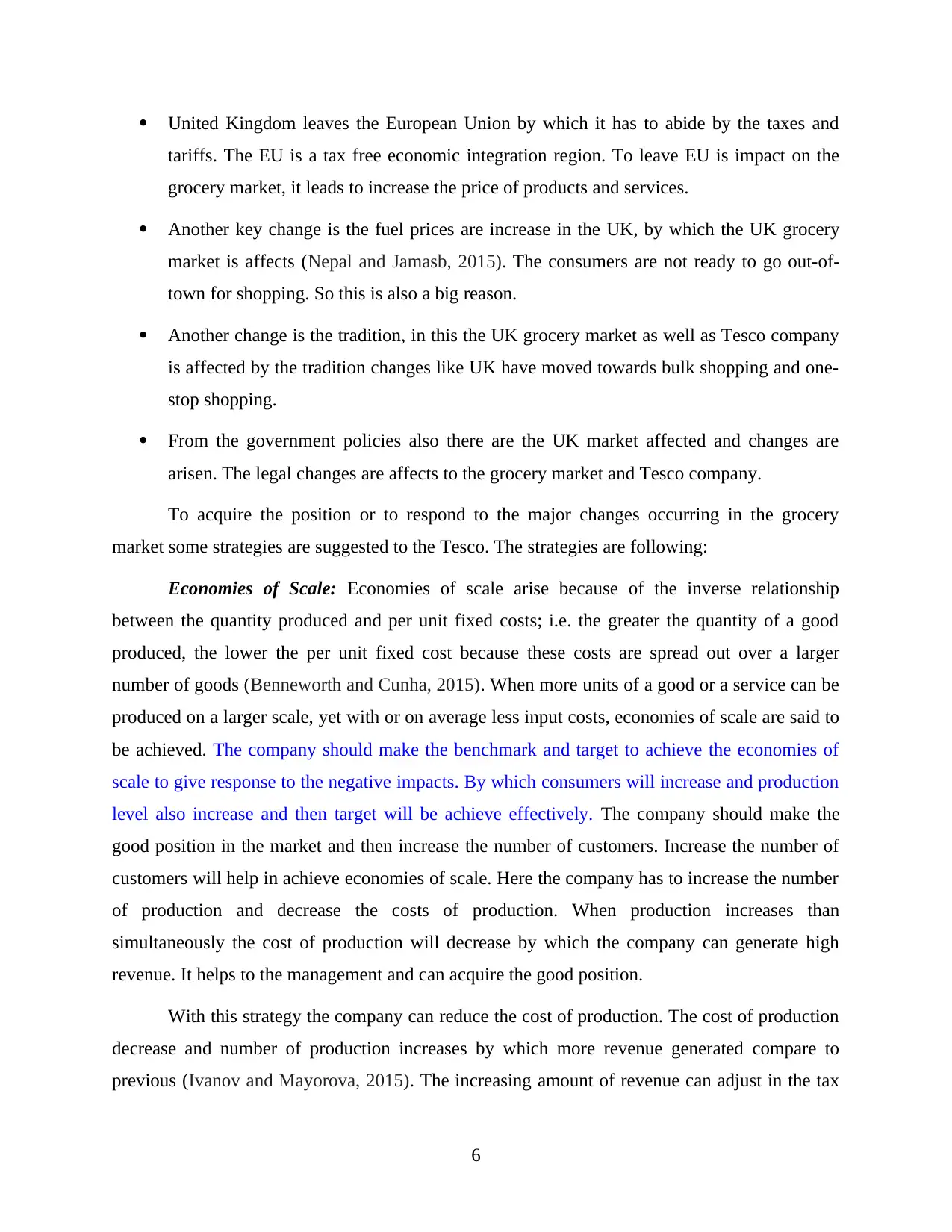
United Kingdom leaves the European Union by which it has to abide by the taxes and
tariffs. The EU is a tax free economic integration region. To leave EU is impact on the
grocery market, it leads to increase the price of products and services.
Another key change is the fuel prices are increase in the UK, by which the UK grocery
market is affects (Nepal and Jamasb, 2015). The consumers are not ready to go out-of-
town for shopping. So this is also a big reason.
Another change is the tradition, in this the UK grocery market as well as Tesco company
is affected by the tradition changes like UK have moved towards bulk shopping and one-
stop shopping.
From the government policies also there are the UK market affected and changes are
arisen. The legal changes are affects to the grocery market and Tesco company.
To acquire the position or to respond to the major changes occurring in the grocery
market some strategies are suggested to the Tesco. The strategies are following:
Economies of Scale: Economies of scale arise because of the inverse relationship
between the quantity produced and per unit fixed costs; i.e. the greater the quantity of a good
produced, the lower the per unit fixed cost because these costs are spread out over a larger
number of goods (Benneworth and Cunha, 2015). When more units of a good or a service can be
produced on a larger scale, yet with or on average less input costs, economies of scale are said to
be achieved. The company should make the benchmark and target to achieve the economies of
scale to give response to the negative impacts. By which consumers will increase and production
level also increase and then target will be achieve effectively. The company should make the
good position in the market and then increase the number of customers. Increase the number of
customers will help in achieve economies of scale. Here the company has to increase the number
of production and decrease the costs of production. When production increases than
simultaneously the cost of production will decrease by which the company can generate high
revenue. It helps to the management and can acquire the good position.
With this strategy the company can reduce the cost of production. The cost of production
decrease and number of production increases by which more revenue generated compare to
previous (Ivanov and Mayorova, 2015). The increasing amount of revenue can adjust in the tax
6
tariffs. The EU is a tax free economic integration region. To leave EU is impact on the
grocery market, it leads to increase the price of products and services.
Another key change is the fuel prices are increase in the UK, by which the UK grocery
market is affects (Nepal and Jamasb, 2015). The consumers are not ready to go out-of-
town for shopping. So this is also a big reason.
Another change is the tradition, in this the UK grocery market as well as Tesco company
is affected by the tradition changes like UK have moved towards bulk shopping and one-
stop shopping.
From the government policies also there are the UK market affected and changes are
arisen. The legal changes are affects to the grocery market and Tesco company.
To acquire the position or to respond to the major changes occurring in the grocery
market some strategies are suggested to the Tesco. The strategies are following:
Economies of Scale: Economies of scale arise because of the inverse relationship
between the quantity produced and per unit fixed costs; i.e. the greater the quantity of a good
produced, the lower the per unit fixed cost because these costs are spread out over a larger
number of goods (Benneworth and Cunha, 2015). When more units of a good or a service can be
produced on a larger scale, yet with or on average less input costs, economies of scale are said to
be achieved. The company should make the benchmark and target to achieve the economies of
scale to give response to the negative impacts. By which consumers will increase and production
level also increase and then target will be achieve effectively. The company should make the
good position in the market and then increase the number of customers. Increase the number of
customers will help in achieve economies of scale. Here the company has to increase the number
of production and decrease the costs of production. When production increases than
simultaneously the cost of production will decrease by which the company can generate high
revenue. It helps to the management and can acquire the good position.
With this strategy the company can reduce the cost of production. The cost of production
decrease and number of production increases by which more revenue generated compare to
previous (Ivanov and Mayorova, 2015). The increasing amount of revenue can adjust in the tax
6
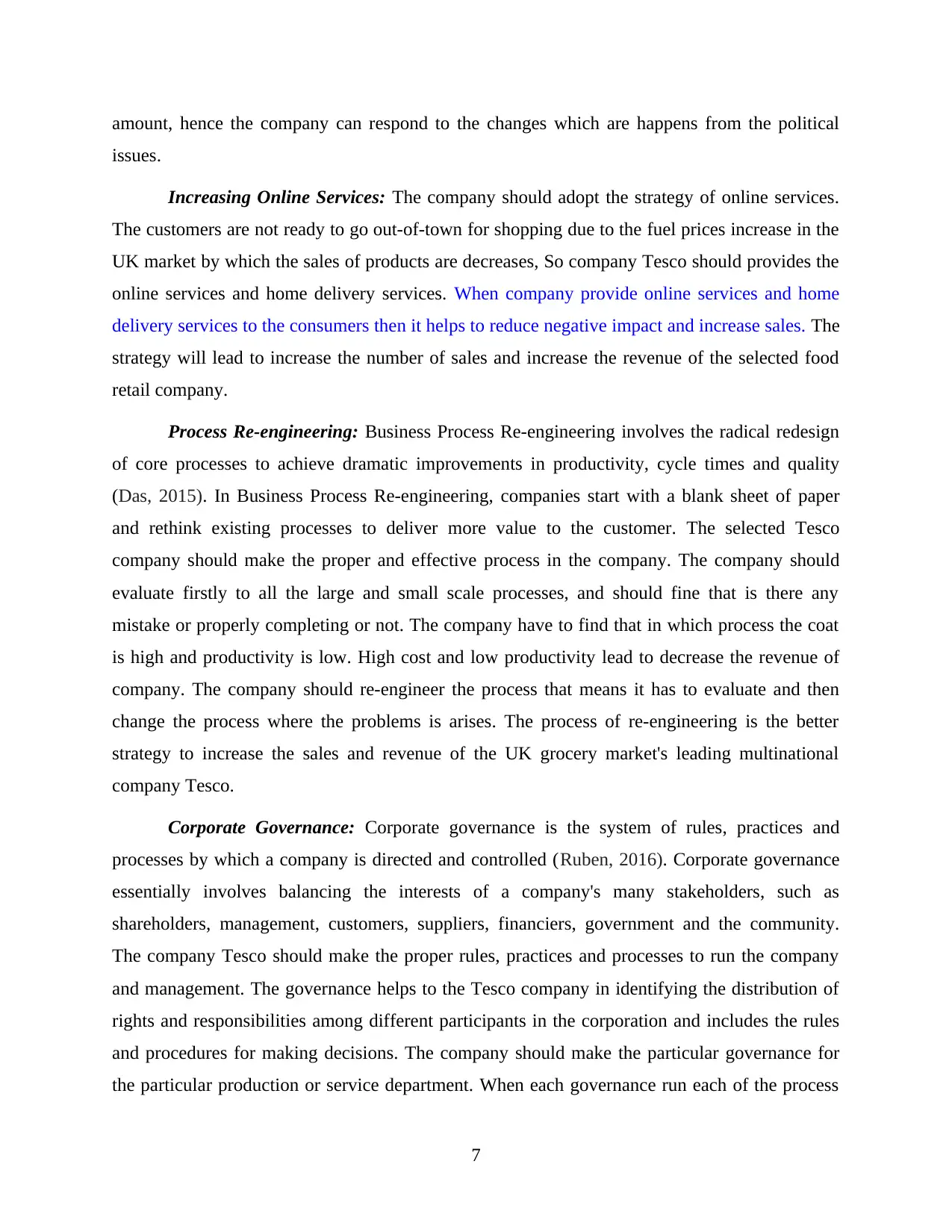
amount, hence the company can respond to the changes which are happens from the political
issues.
Increasing Online Services: The company should adopt the strategy of online services.
The customers are not ready to go out-of-town for shopping due to the fuel prices increase in the
UK market by which the sales of products are decreases, So company Tesco should provides the
online services and home delivery services. When company provide online services and home
delivery services to the consumers then it helps to reduce negative impact and increase sales. The
strategy will lead to increase the number of sales and increase the revenue of the selected food
retail company.
Process Re-engineering: Business Process Re-engineering involves the radical redesign
of core processes to achieve dramatic improvements in productivity, cycle times and quality
(Das, 2015). In Business Process Re-engineering, companies start with a blank sheet of paper
and rethink existing processes to deliver more value to the customer. The selected Tesco
company should make the proper and effective process in the company. The company should
evaluate firstly to all the large and small scale processes, and should fine that is there any
mistake or properly completing or not. The company have to find that in which process the coat
is high and productivity is low. High cost and low productivity lead to decrease the revenue of
company. The company should re-engineer the process that means it has to evaluate and then
change the process where the problems is arises. The process of re-engineering is the better
strategy to increase the sales and revenue of the UK grocery market's leading multinational
company Tesco.
Corporate Governance: Corporate governance is the system of rules, practices and
processes by which a company is directed and controlled (Ruben, 2016). Corporate governance
essentially involves balancing the interests of a company's many stakeholders, such as
shareholders, management, customers, suppliers, financiers, government and the community.
The company Tesco should make the proper rules, practices and processes to run the company
and management. The governance helps to the Tesco company in identifying the distribution of
rights and responsibilities among different participants in the corporation and includes the rules
and procedures for making decisions. The company should make the particular governance for
the particular production or service department. When each governance run each of the process
7
issues.
Increasing Online Services: The company should adopt the strategy of online services.
The customers are not ready to go out-of-town for shopping due to the fuel prices increase in the
UK market by which the sales of products are decreases, So company Tesco should provides the
online services and home delivery services. When company provide online services and home
delivery services to the consumers then it helps to reduce negative impact and increase sales. The
strategy will lead to increase the number of sales and increase the revenue of the selected food
retail company.
Process Re-engineering: Business Process Re-engineering involves the radical redesign
of core processes to achieve dramatic improvements in productivity, cycle times and quality
(Das, 2015). In Business Process Re-engineering, companies start with a blank sheet of paper
and rethink existing processes to deliver more value to the customer. The selected Tesco
company should make the proper and effective process in the company. The company should
evaluate firstly to all the large and small scale processes, and should fine that is there any
mistake or properly completing or not. The company have to find that in which process the coat
is high and productivity is low. High cost and low productivity lead to decrease the revenue of
company. The company should re-engineer the process that means it has to evaluate and then
change the process where the problems is arises. The process of re-engineering is the better
strategy to increase the sales and revenue of the UK grocery market's leading multinational
company Tesco.
Corporate Governance: Corporate governance is the system of rules, practices and
processes by which a company is directed and controlled (Ruben, 2016). Corporate governance
essentially involves balancing the interests of a company's many stakeholders, such as
shareholders, management, customers, suppliers, financiers, government and the community.
The company Tesco should make the proper rules, practices and processes to run the company
and management. The governance helps to the Tesco company in identifying the distribution of
rights and responsibilities among different participants in the corporation and includes the rules
and procedures for making decisions. The company should make the particular governance for
the particular production or service department. When each governance run each of the process
7
⊘ This is a preview!⊘
Do you want full access?
Subscribe today to unlock all pages.

Trusted by 1+ million students worldwide
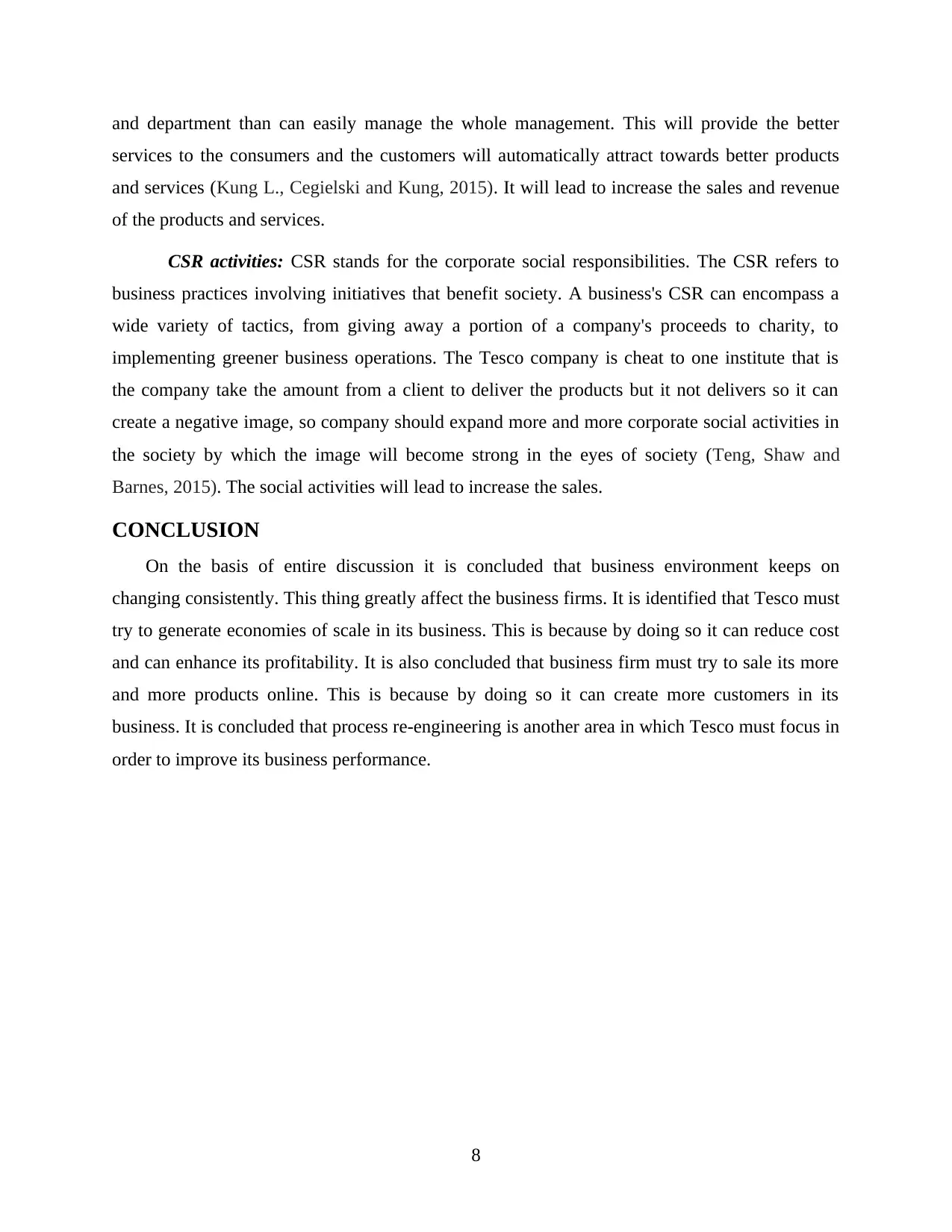
and department than can easily manage the whole management. This will provide the better
services to the consumers and the customers will automatically attract towards better products
and services (Kung L., Cegielski and Kung, 2015). It will lead to increase the sales and revenue
of the products and services.
CSR activities: CSR stands for the corporate social responsibilities. The CSR refers to
business practices involving initiatives that benefit society. A business's CSR can encompass a
wide variety of tactics, from giving away a portion of a company's proceeds to charity, to
implementing greener business operations. The Tesco company is cheat to one institute that is
the company take the amount from a client to deliver the products but it not delivers so it can
create a negative image, so company should expand more and more corporate social activities in
the society by which the image will become strong in the eyes of society (Teng, Shaw and
Barnes, 2015). The social activities will lead to increase the sales.
CONCLUSION
On the basis of entire discussion it is concluded that business environment keeps on
changing consistently. This thing greatly affect the business firms. It is identified that Tesco must
try to generate economies of scale in its business. This is because by doing so it can reduce cost
and can enhance its profitability. It is also concluded that business firm must try to sale its more
and more products online. This is because by doing so it can create more customers in its
business. It is concluded that process re-engineering is another area in which Tesco must focus in
order to improve its business performance.
8
services to the consumers and the customers will automatically attract towards better products
and services (Kung L., Cegielski and Kung, 2015). It will lead to increase the sales and revenue
of the products and services.
CSR activities: CSR stands for the corporate social responsibilities. The CSR refers to
business practices involving initiatives that benefit society. A business's CSR can encompass a
wide variety of tactics, from giving away a portion of a company's proceeds to charity, to
implementing greener business operations. The Tesco company is cheat to one institute that is
the company take the amount from a client to deliver the products but it not delivers so it can
create a negative image, so company should expand more and more corporate social activities in
the society by which the image will become strong in the eyes of society (Teng, Shaw and
Barnes, 2015). The social activities will lead to increase the sales.
CONCLUSION
On the basis of entire discussion it is concluded that business environment keeps on
changing consistently. This thing greatly affect the business firms. It is identified that Tesco must
try to generate economies of scale in its business. This is because by doing so it can reduce cost
and can enhance its profitability. It is also concluded that business firm must try to sale its more
and more products online. This is because by doing so it can create more customers in its
business. It is concluded that process re-engineering is another area in which Tesco must focus in
order to improve its business performance.
8
Paraphrase This Document
Need a fresh take? Get an instant paraphrase of this document with our AI Paraphraser
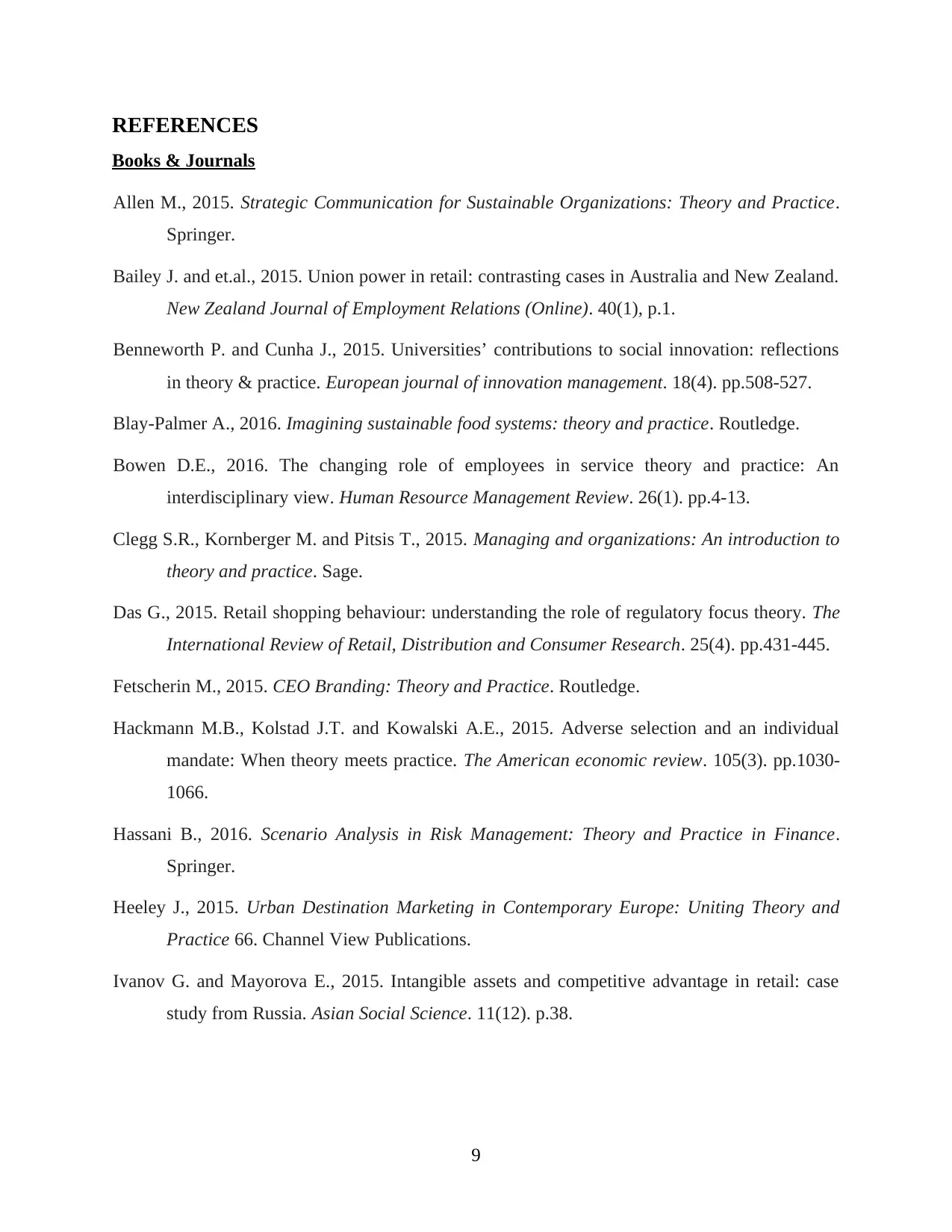
REFERENCES
Books & Journals
Allen M., 2015. Strategic Communication for Sustainable Organizations: Theory and Practice.
Springer.
Bailey J. and et.al., 2015. Union power in retail: contrasting cases in Australia and New Zealand.
New Zealand Journal of Employment Relations (Online). 40(1), p.1.
Benneworth P. and Cunha J., 2015. Universities’ contributions to social innovation: reflections
in theory & practice. European journal of innovation management. 18(4). pp.508-527.
Blay-Palmer A., 2016. Imagining sustainable food systems: theory and practice. Routledge.
Bowen D.E., 2016. The changing role of employees in service theory and practice: An
interdisciplinary view. Human Resource Management Review. 26(1). pp.4-13.
Clegg S.R., Kornberger M. and Pitsis T., 2015. Managing and organizations: An introduction to
theory and practice. Sage.
Das G., 2015. Retail shopping behaviour: understanding the role of regulatory focus theory. The
International Review of Retail, Distribution and Consumer Research. 25(4). pp.431-445.
Fetscherin M., 2015. CEO Branding: Theory and Practice. Routledge.
Hackmann M.B., Kolstad J.T. and Kowalski A.E., 2015. Adverse selection and an individual
mandate: When theory meets practice. The American economic review. 105(3). pp.1030-
1066.
Hassani B., 2016. Scenario Analysis in Risk Management: Theory and Practice in Finance.
Springer.
Heeley J., 2015. Urban Destination Marketing in Contemporary Europe: Uniting Theory and
Practice 66. Channel View Publications.
Ivanov G. and Mayorova E., 2015. Intangible assets and competitive advantage in retail: case
study from Russia. Asian Social Science. 11(12). p.38.
9
Books & Journals
Allen M., 2015. Strategic Communication for Sustainable Organizations: Theory and Practice.
Springer.
Bailey J. and et.al., 2015. Union power in retail: contrasting cases in Australia and New Zealand.
New Zealand Journal of Employment Relations (Online). 40(1), p.1.
Benneworth P. and Cunha J., 2015. Universities’ contributions to social innovation: reflections
in theory & practice. European journal of innovation management. 18(4). pp.508-527.
Blay-Palmer A., 2016. Imagining sustainable food systems: theory and practice. Routledge.
Bowen D.E., 2016. The changing role of employees in service theory and practice: An
interdisciplinary view. Human Resource Management Review. 26(1). pp.4-13.
Clegg S.R., Kornberger M. and Pitsis T., 2015. Managing and organizations: An introduction to
theory and practice. Sage.
Das G., 2015. Retail shopping behaviour: understanding the role of regulatory focus theory. The
International Review of Retail, Distribution and Consumer Research. 25(4). pp.431-445.
Fetscherin M., 2015. CEO Branding: Theory and Practice. Routledge.
Hackmann M.B., Kolstad J.T. and Kowalski A.E., 2015. Adverse selection and an individual
mandate: When theory meets practice. The American economic review. 105(3). pp.1030-
1066.
Hassani B., 2016. Scenario Analysis in Risk Management: Theory and Practice in Finance.
Springer.
Heeley J., 2015. Urban Destination Marketing in Contemporary Europe: Uniting Theory and
Practice 66. Channel View Publications.
Ivanov G. and Mayorova E., 2015. Intangible assets and competitive advantage in retail: case
study from Russia. Asian Social Science. 11(12). p.38.
9
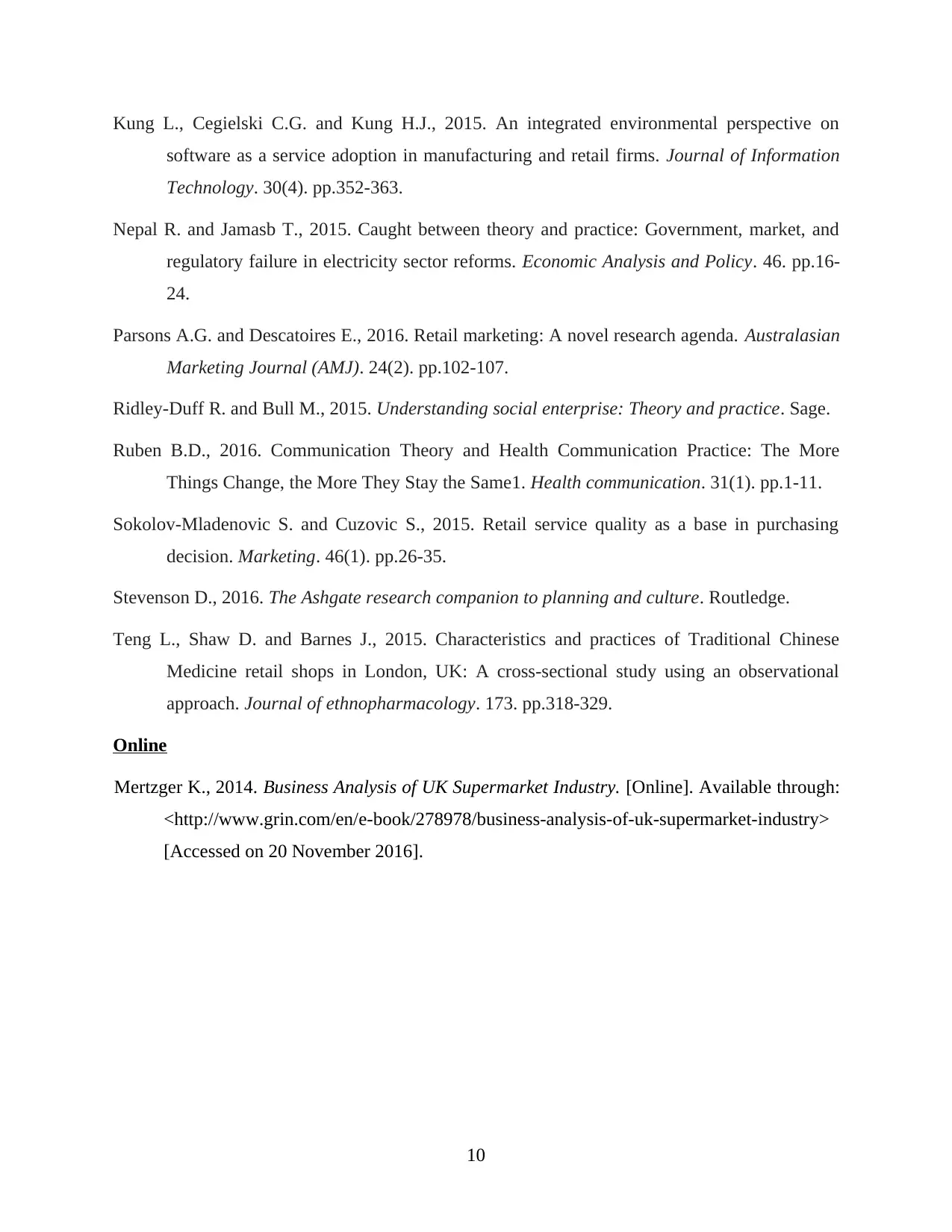
Kung L., Cegielski C.G. and Kung H.J., 2015. An integrated environmental perspective on
software as a service adoption in manufacturing and retail firms. Journal of Information
Technology. 30(4). pp.352-363.
Nepal R. and Jamasb T., 2015. Caught between theory and practice: Government, market, and
regulatory failure in electricity sector reforms. Economic Analysis and Policy. 46. pp.16-
24.
Parsons A.G. and Descatoires E., 2016. Retail marketing: A novel research agenda. Australasian
Marketing Journal (AMJ). 24(2). pp.102-107.
Ridley-Duff R. and Bull M., 2015. Understanding social enterprise: Theory and practice. Sage.
Ruben B.D., 2016. Communication Theory and Health Communication Practice: The More
Things Change, the More They Stay the Same1. Health communication. 31(1). pp.1-11.
Sokolov-Mladenovic S. and Cuzovic S., 2015. Retail service quality as a base in purchasing
decision. Marketing. 46(1). pp.26-35.
Stevenson D., 2016. The Ashgate research companion to planning and culture. Routledge.
Teng L., Shaw D. and Barnes J., 2015. Characteristics and practices of Traditional Chinese
Medicine retail shops in London, UK: A cross-sectional study using an observational
approach. Journal of ethnopharmacology. 173. pp.318-329.
Online
Mertzger K., 2014. Business Analysis of UK Supermarket Industry. [Online]. Available through:
<http://www.grin.com/en/e-book/278978/business-analysis-of-uk-supermarket-industry>
[Accessed on 20 November 2016].
10
software as a service adoption in manufacturing and retail firms. Journal of Information
Technology. 30(4). pp.352-363.
Nepal R. and Jamasb T., 2015. Caught between theory and practice: Government, market, and
regulatory failure in electricity sector reforms. Economic Analysis and Policy. 46. pp.16-
24.
Parsons A.G. and Descatoires E., 2016. Retail marketing: A novel research agenda. Australasian
Marketing Journal (AMJ). 24(2). pp.102-107.
Ridley-Duff R. and Bull M., 2015. Understanding social enterprise: Theory and practice. Sage.
Ruben B.D., 2016. Communication Theory and Health Communication Practice: The More
Things Change, the More They Stay the Same1. Health communication. 31(1). pp.1-11.
Sokolov-Mladenovic S. and Cuzovic S., 2015. Retail service quality as a base in purchasing
decision. Marketing. 46(1). pp.26-35.
Stevenson D., 2016. The Ashgate research companion to planning and culture. Routledge.
Teng L., Shaw D. and Barnes J., 2015. Characteristics and practices of Traditional Chinese
Medicine retail shops in London, UK: A cross-sectional study using an observational
approach. Journal of ethnopharmacology. 173. pp.318-329.
Online
Mertzger K., 2014. Business Analysis of UK Supermarket Industry. [Online]. Available through:
<http://www.grin.com/en/e-book/278978/business-analysis-of-uk-supermarket-industry>
[Accessed on 20 November 2016].
10
⊘ This is a preview!⊘
Do you want full access?
Subscribe today to unlock all pages.

Trusted by 1+ million students worldwide
1 out of 12
Related Documents
Your All-in-One AI-Powered Toolkit for Academic Success.
+13062052269
info@desklib.com
Available 24*7 on WhatsApp / Email
![[object Object]](/_next/static/media/star-bottom.7253800d.svg)
Unlock your academic potential
Copyright © 2020–2025 A2Z Services. All Rights Reserved. Developed and managed by ZUCOL.





